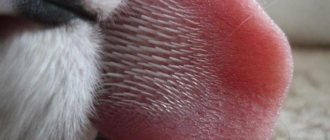Hemorrhoids in cats are a fairly rare disease that occurs due to varicose veins in the anus and rectum. Most people consider the disease to be exclusively “human”, since it is predisposed to the fact that we move on two limbs, unlike our smaller brothers, thereby creating additional stress on the blood vessels. The question of whether cats have hemorrhoids, in the literal sense of the word, even nowadays causes a lot of controversy among veterinarians, since in most cases it means any ailment that provokes inflammation of the anus in a pet.
That is why, at the first signs of the appearance of bright red tumors in the animal’s anus, the owner urgently needs to take him for examination to a specialist, who can differentiate hemorrhoids caused by varicose veins from rectal prolapse or inflammation of the paraanal glands. In advanced cases and without proper treatment, there is a high risk that the pet will die. The article will discuss what to do if hemorrhoids are detected, what are its signs and symptoms, as well as how to treat this disease.
Causes of the disease
Most owners sincerely believe that such an ailment as varicose veins of the rectum is unique to humans. However, oddly enough, feline hemorrhoids also exist. The causes of this disease can be very different. Among them are:
Hemorrhoids in cats
- The properties of the blood were disrupted and it became thicker.
- Increased amount of cholesterol in the body, obesity.
- The disease is caused by diabetes mellitus.
- Regular intestinal problems, frequent constipation.
- Physical activity is too much or, conversely, too little.
- Hormonal imbalances.
Important! The disease causes serious inconvenience to the pet, and if the symptoms are ignored, it can develop into quite severe pathological conditions.
Do male cats get hemorrhoids?
Dilation of the veins in the rectum in mustachioed pets is a rare, but still common phenomenon. Inflammation caused by impaired blood flow leads to deformation of blood vessels. They intertwine into knots and fall out of the anus, causing unpleasant and painful sensations during emptying.
If you suspect that your cat has hemorrhoids, check with your veterinarian about what to do. Despite the similarity of the main symptoms of the disease, the treatment of mustachioed pets and humans is very different.
Risk group
Snot in a kitten, cat and cat: how to treat it
A variety of felines are susceptible to the disease. Pets at risk include:
- Spayed or neutered. In this case, the disease may develop due to changes in the animal’s hormonal levels.
- Breeds prone to obesity. These include: British, Scottish Fold, and so on. For them, it is necessary to select special food and carefully monitor the animal’s weight.
- Cats eating low-quality foods, such as dry food such as Whiskas or a cheaper category.
- Having a genetic tendency passed on from their parents.
Obesity can cause hemorrhoids in cats
Causes of the disease
The main cause of feline hemorrhoids is blood stagnation, which reduces the tone of the blood vessels. This dangerous violation occurs under the following factors:
- advanced form of worm infection;
- cancerous tumors in the intestines;
- excess weight, fraught with the growth of cholesterol plaques;
- diseases of the urinary system (cystitis, urolithiasis);
- excessive or low physical activity;
- too short breaks between matings in breeding animals (with frequent pregnancies, the pressure in the pelvis remains at a dangerously high level);
- intestinal obstruction and frequent constipation;
- dehydration and poor nutrition (low amount of vitamins and lack of balance of KBJU);
- hormonal imbalances.
If your pet eats economy-class food, is neutered or is prone to obesity (Sphinxes, Persians, British), then he is at risk. A predisposition to pathology is inherited, so when buying a kitten, be sure to check all the diseases that its parents have encountered.
Main symptoms of hemorrhoids in cats
Hemorrhoids in a cat can be suspected even in the earliest stages. However, to do this, the owner needs to closely monitor his pet.
Blood in a cat from the anus, in a cat and a kitten
How do hemorrhoids manifest in a cat?
- The gait changes. The pet spreads its paws wide, trying to somehow get rid of the unpleasant sensations.
- The cat constantly licks the painful area. The psychological state changes. She becomes nervous and restless.
- Problems with stool. The animal begins to meow when it tries to go into the litter box. The stool is hard and you may notice bloody or mucous discharge.
- Inflammation of the anus is palpable. There is significant compaction.
At an early (mild) stage
The early stage has almost no external manifestations. The disease can be determined by the behavior of the animal. The cat becomes lethargic, eats less, and has problems with stool.
Important! In particular, what the owner should pay attention to is the discharge. Hard stools with mucous or blood traces are a clear sign of an unhealthy pet.
When transitioning to a severe form
The late, advanced stage of the disease is characterized by bleeding wounds and ulcers. The animal becomes painful and uncomfortable to walk.
Hemorrhoids in a kitten or adult cat in a severe stage may require surgical intervention.
Symptoms of pathology
Symptoms of hemorrhoids in cats develop progressively. You can notice a disorder at an early stage only by behavioral changes, so it is very important not to ignore your pet’s mood changes.
Signs at different stages
A sick pet becomes nervous and restless. He loses his usual activity and appetite, devoting most of his time to anal hygiene.
More obvious signs develop in 3 stages:
- The hemorrhoid is located inside. It cannot be detected visually, but can be felt. The small compaction takes on a spherical shape.
- The node, swollen with blood, gradually falls out. The round shape changes to a cone shape.
- Under pressure, the vessels become thinner, so during defecation they are injured and bleed. At the site of the bump, a small bleeding ulcer appears, gradually increasing in size.
The resulting pain affects gait and bowel movements. When moving, the animal spreads its hind legs wide, trying not to touch the deformed veins. There is stool retention, drying of stool, and the appearance of mucous and bright scarlet discharge.
If your pet meows pitifully in the toilet, and its anus is red and swollen, sign up for an examination at the veterinary clinic. Otherwise, an infection may get into the open wound, aggravating the patient’s condition and complicating further treatment.
Similar diseases
Prolapse of hemorrhoids is a fairly rare pathology, so do not rush to look for a cure before making a diagnosis. Most often, the cause of the disorder is other diseases with similar symptoms:
- neoplasms and hernia in the intestine, as well as rectal prolapse, characteristic of animals with weak sphincter muscles;
- inflammation of the paraanal glands - small sacs with odorous secretions located immediately behind the entrance to the anus;
- helminthic infestation, accompanied by frequent licking due to itching;
- anal fissure, that is, spontaneous damage to the mucosa;
- ulcerative colitis, or inflammation of the large intestine.
Despite the similarity of symptoms, all of these diseases have different treatment regimens. For this reason, you should not draw conclusions until your pet is fully examined.
What is hemorrhoids confused with?
There aren't many conditions that can look like hemorrhoids, but they do exist. It should be remembered that cats have two anal glands next to the sphincter. They are necessary for the animal to create its own individual smell, serve as an antiseptic and produce a kind of lubricant that facilitates easier excretion of feces.
A cat's eyesore: how to treat it at home
These glands may become inflamed. The symptoms that appear in this case are very similar to hemorrhoids and they are quite easy to confuse.
The second ailment that has similar symptoms is “itching in the anus.” Outwardly, this manifests itself in the form of hair loss in a place close to the anus. At the same time, the animal often fidgets on the floor with the back of its body.
Another option is rectal prolapse. It can fall out after a long eating disorder. This can also occur due to age-related changes. Outwardly, the prolapse resembles hemorrhoids, but in reality it is not.
Important! Each disease requires special treatment, which cannot be started without a correct diagnosis.
Disease prevention
It is important to understand that hemorrhoids are easier to prevent than to treat. The following recommendations will help owners protect their cats from the development of pathology:
- Once every 6 months it is necessary to carry out mandatory deworming of the animal;
- carefully monitor the weight of your mustachioed friend; at the first signs of obesity, increase his physical activity and adjust his diet;
- if the owner notices that a kitten or adult does not have the habit of caring for its anus, then it should be done independently, using a damp cloth;
- If your cat has prolonged diarrhea or constipation, seek help from a veterinarian;
- The pet should have free access to clean water.
By following these simple tips you can reduce the risk of hemorrhoids to zero. Remember that in many respects the health of your furry pet depends solely on you.
Diagnosis of the disease
Hemorrhoids in a cat and how to treat it depend on what caused it, since such an ailment is very unusual for representatives of the cat family. Blood clotting will need to be checked. For this purpose, a coagulogram is performed.
In addition, doctors recommend testing animals for hormones and determining blood sugar levels. It is also necessary to check the stool for the presence of parasites and their eggs. In addition, the veterinarian examines the anus and evaluates the general condition of the anal glands.
Symptoms of the disease
Veterinarians agree that the signs of hemorrhoids in cats are almost identical to how they appear in humans. The most striking symptoms are expressed as follows:
- the cat's anus characteristically turns red;
- The feces excreted by the animal are predominantly dry interspersed with blood fluid;
- in the anus area, nodules and small bumps can be seen with the naked eye;
- the pet becomes nervous, constantly licks the anus, unsuccessfully trying to get rid of the painful sensations;
- When moving, the pet unnaturally spreads its hind legs.
If the owner notices similar symptoms in his pet, then the best thing he can do is take the cat to see a doctor. Due to the fact that hemorrhoids can easily be confused with inflammation of the anal glands, and the treatment of these diseases is radically different, attempts to cope with the problem at home, without prior consultation with a specialist, are unacceptable, as they can lead to a fatal outcome for the pet.
Treatment of hemorrhoids in cats
An important step in treating the disease is reducing or increasing physical activity (depending on the cause of the disease). Active games are catch-up games for lazy people or, conversely, maximum peace for those who play too much.
The next point is hygiene. People are used to cats licking themselves. However, with such a disease, a person will have to regularly wash the anus and perineum of his pet. The procedure is carried out at least 2-3 times a day. Use warm water and soap. It is allowed to use special napkins that are sold in veterinary hospitals and pharmacies.
For reference! The disease is quite easy to cure in the early stages and does not cause much discomfort to the animal.
Levomekol can be used as a medicine in the initial stages. It is recommended to give your pet herbal tinctures that would help fight the disease from the inside. Full recovery occurs after a month.
In cases where the disease has already reached a serious stage and there is a serious threat to the life and health of the pet, the doctor prescribes surgery. Surgery can be performed in two ways.
- In the first, part of the intestine is frozen with liquid nitrogen and removed. This is the fastest, but less commonly used type of surgery.
- In the second case, the hemorrhoids and dilated areas of the veins located next to the mucosa are removed.
The doctor's consultation
Treatment
At the initial - mild stage
In the initial stages of the disease, it is quite possible to get by with home treatment with herbal preparations. Before starting therapy, it is worth adjusting your pet’s diet - alternate wet and dry food, give plenty of clean water to drink. Introduce into the menu foods enriched with fiber and dietary fiber - they help form feces and facilitate bowel movements. It is also recommended to give fermented milk products.
The basis of treatment is to ensure proper hygienic care of the anal area. Be sure to wash your cat's anus 2-3 times a day with warm water without soap, using damp non-woven wipes for wiping. After such procedures, lubricate the sphincter area with petroleum jelly or Levomekol mallow.
To relieve inflammation and have an antiseptic effect, suppositories with ichthyol or furazolidone are used. You can also give yarrow infusion in small quantities; it helps relieve inflammation, relieve pain and reduce the formation of blood clots. For the same purposes, you can use candles with ichthyol or Divopride.
When transitioning to a severe form
If the disease has progressed to a severe form with large and ulcerated nodes, the help of a surgeon will be needed. Depending on the characteristics of the process, 2 types of operations are used:
- Using liquid nitrogen, the cones are frozen and then removed. It is minimally invasive and requires only local anesthesia.
- Surgical excision - with the help of instruments, dilated veins and the adjacent mucous membrane are removed.
After operations, it is recommended to limit the cat’s activity and introduce an additional course of multivitamins, as well as use wound healing ointments (Iruksovetin, Ranosan) and drugs to speed up recovery (Tsamax, Gamavit).
What to feed a cat with constipation
After a cat has been diagnosed with hemorrhoids, what to do next? First of all, owners will have to switch their pets to proper and balanced nutrition. In this case, it is recommended to completely abandon the use of dry food.
The cat is transferred to canned food of exceptionally high quality. The bottom line is that cheap manufacturers use low-quality and sometimes harmful raw materials. Such food can only make the situation worse.
Food prepared independently will also have a positive effect on the animal’s condition. It is necessary that the diet necessarily include meat and vegetables. If the cat is dehydrated, additional minerals are added. It is also worth ensuring that the animal has constant access to water.
Causes of the disease
Having dealt with ailments similar to hemorrhoids, you should move on to the reasons that provoke the disease in question:
- poor diet, poor in microelements and vitamins. Hemorrhoids occur especially often in those pets who “sit” exclusively on cheap dry food;
- disruptions in the gastrointestinal tract caused by poor nutrition. This is a constant source of problems with bowel movements, which over time leads to the appearance of an unpleasant illness;
- excess weight that your furry friend suffers from. The risk zone includes animals living in apartments and therefore deprived of active physical activity, as well as cats that have undergone castration;
- pathology sometimes occurs against the background of diabetes, which causes the walls of blood vessels and veins to lose their original elasticity;
- disturbances in the functioning of the endocrine system;
- the presence of worms in the cat’s body.
Each of the above reasons leads to blood stagnating in the cat’s veins, leading to the formation of nodules. They can be located both inside and fall out of the anus.
Care and rehabilitation
As statistics show, even at an advanced stage, if you contact a veterinary clinic in a timely manner, the prognosis of the disease is positive. Most animals undergo the further course of rehabilitation well.
However, just like people, pets will still need to go through a rehabilitation period and will require special care.
Step-by-step instruction:
- Food should be of high quality and rich in fiber and microelements. Dry food is used to a minimum. An important condition is that only high-quality dry food is used.
- Carrying out hygiene procedures. Either the pet washes itself, or it will need the help of its owner.
- After surgery, your pet needs rest. Wound healing medications prescribed by your doctor will need to be rubbed into the anus.
Balanced diet
Diet and care
The main goals of a therapeutic diet are to return the natural consistency of stool and reduce the load on the inflamed intestines. New nutrition involves:
- Switch to easily digestible foods. All dishes are boiled or steamed, since the lack of heat treatment complicates the digestion process. You can cook rice, oatmeal or buckwheat porridge using the broth left after cooking meat.
- Chop food thoroughly before serving. Too large an unchewed piece can injure the mucous membrane.
- Enriching the diet with fiber and vitamins. Use special probiotics, vitamin complexes or bran soaked in kefir. Remember that all fermented milk products must have minimal fat content and an expiration date.
- Switching to veterinary food. The lack of water is compensated for with wet canned food from the same line, intended for the treatment of gastrointestinal pathologies.
In addition to changing your diet, it is important to reconsider your existing load. Fluffy couch potatoes are encouraged to play actively, and pets that are too restless are temporarily restricted in their movements.
Before recovery, you need to take care of hygiene. Clean the anus and perineum twice daily with warm water or alcohol-free wipes. After washing, be sure to lubricate the anus with antiseptic ointment or Vaseline oil. This will prevent infection from entering the wound and speed up its healing.
What to do if a kitten has hemorrhoids
Hemorrhoids are considered to be a pathology that only affects humans, but in cats, like other animals, it is understood as any disease associated with inflammation of the anus. However, in a number of foreign veterinary reference books there is a description of hemorrhoids in cats, but this is rather an exception.
We will talk about whether cats get hemorrhoids, what diseases are confused with it, and how to treat your pet correctly.
Causes of hemorrhoids in cats
What causes hemorrhoids in a cat?
Walking on two legs, upright posture, is one of the characteristics of man, which not only distinguishes him from animals, but also has a number of negative aspects.
A person’s center of gravity is shifted, which leads to diseases of the spine and poor circulation in the pelvic area, which leads to hemorrhoids in cats.
In cats, the center of gravity is fine, but problems with the intestines and blood vessels arise for a number of other reasons.
https://www.youtube.com/watch?v=ZYzB851_h1A
The most common ones are the following:
- improper and inadequate nutrition. Leads to a number of diseases, including hemorrhoids. Most often, those cats that get sick are those that are fed only cheap dry food from the store;
- digestive disorders. A direct consequence of poor nutrition, which leads to constant constipation and disorders;
- overweight. A frequent companion of apartment cats, it can also appear after the cat has been castrated;
- lack of physical activity;
- diabetes and a number of other diseases that lead to the walls of blood vessels and veins losing their elasticity and firmness;
- hormonal disorders;
- helminths, in simple terms, worms.
All these factors lead to the fact that the veins lose their tone, and blood stagnation begins in them, nodules form. Moreover, these nodules can be either inside or fall out through the anus.
Inflammation of the anal glands
What diseases are hemorrhoids confused with in cats?
In cats, in the rectum near the sphincter there are two anal glands, which produce a secretion that is not only the source of the individual smell of the animal, but also a powerful antiseptic.
In addition, they secrete a “lubricant” that facilitates the passage of feces. It is the inflammation of these glands that is most often mistaken for hemorrhoids.
Meanwhile, an attempt at improper treatment will lead to the formation of fistulas and a severe inflammatory process.
Itching in the anus
The cat begins to “ride” along the floor with its hind end, the hair falls out around the sphincter, inflammation and swelling appear. A very common occurrence with worms.
Rectal prolapse
Rectal prolapse occurs in cats as a consequence of long-term digestive disorders, as well as with senile changes, when tissues and muscles lose their firmness and elasticity. Bowel prolapse is very similar to, but is not, the later stages of hemorrhoids.
How to treat hemorrhoids in a cat
How to cure hemorrhoids in a cat
If the pathology is detected at an early stage, then the treatment will be quite “gentle”; the main thing in it will be to normalize the animal’s nutrition so that its gastrointestinal tract works “like a clock.” You will have to forget about dry food from the store. The diet should be as balanced as possible, with all vitamins, minerals and trace elements.
Pay special attention to fiber, it is responsible for the normal formation of feces and bowel movements. Wash your cat's anus several times a day with warm water, without using soap or other products. After the procedure, lubricate the anus with a small amount of Levomekol, Vaseline or sea buckthorn oil.
If hemorrhoids are already severe, then suppositories will be necessary in the anus, which will relieve inflammation and pain.
If a cat’s hemorrhoids have reached an advanced stage, then it is too late to carry out drug treatment—surgery is necessary. It is performed in a veterinary clinic. There are two main methods: excision of hemorrhoidal cones under general anesthesia or freezing them with liquid nitrogen under local.
Source: https://geraklionmed.ru/chto-delat-esli-u-kotenka-gemorroy/
Are cats prone to hemorrhoids?
It is officially believed that hemorrhoids are a purely human ailment. This is due to the fact that people walk on two legs and maintain good balance with a shifted center of gravity. This hypothesis is confirmed by the fact of a rare manifestation of the disease in higher primates, which are “close relatives” of humans.
Hemorrhoids are a condition that is rare in cats.
But it is not entirely correct to exclude any possibility of hemorrhoids developing in animals. Any “blood-bearing” living creature can suffer from venous blockage. If the owner notices something similar in his cat, he needs to urgently seek qualified help.
Effective ways to treat hemorrhoids in cats and kittens at home
Diseases in cats can be very different. While some owners have long been accustomed to them and know everything about the method of treatment, others may raise serious doubts. The conversation is about hemorrhoids, because cats are susceptible to it.
Risk group
Snot in a kitten, cat and cat: how to treat it
A variety of felines are susceptible to the disease. Pets at risk include:
- Spayed or neutered. In this case, the disease may develop due to changes in the animal’s hormonal levels.
- Breeds prone to obesity. These include: British, Scottish Fold, and so on. For them, it is necessary to select special food and carefully monitor the animal’s weight.
- Cats eating low-quality foods, such as dry food such as Whiskas or a cheaper category.
- Having a genetic tendency passed on from their parents.
Obesity can cause hemorrhoids in cats
Main symptoms of hemorrhoids in cats
Hemorrhoids in a cat can be suspected even in the earliest stages. However, to do this, the owner needs to closely monitor his pet.
Blood in a cat from the anus, in a cat and a kitten
How do hemorrhoids manifest in a cat?
- The gait changes. The pet spreads its paws wide, trying to somehow get rid of the unpleasant sensations.
- The cat constantly licks the painful area. The psychological state changes. She becomes nervous and restless.
- Problems with stool. The animal begins to meow when it tries to go into the litter box. The stool is hard and you may notice bloody or mucous discharge.
- Inflammation of the anus is palpable. There is significant compaction.
At an early (mild) stage
The early stage has almost no external manifestations. The disease can be determined by the behavior of the animal. The cat becomes lethargic, eats less, and has problems with stool.
Important! In particular, what the owner should pay attention to is the discharge. Hard stools with mucous or blood traces are a clear sign of an unhealthy pet.
When transitioning to a severe form
The late, advanced stage of the disease is characterized by bleeding wounds and ulcers. The animal becomes painful and uncomfortable to walk.
Hemorrhoids in a kitten or adult cat in a severe stage may require surgical intervention.
What is hemorrhoids confused with?
There aren't many conditions that can look like hemorrhoids, but they do exist. It should be remembered that cats have two anal glands next to the sphincter. They are necessary for the animal to create its own individual smell, serve as an antiseptic and produce a kind of lubricant that facilitates easier excretion of feces.
A cat's eyesore: how to treat it at home
These glands may become inflamed. The symptoms that appear in this case are very similar to hemorrhoids and they are quite easy to confuse.
The second ailment that has similar symptoms is “itching in the anus.” Outwardly, this manifests itself in the form of hair loss in a place close to the anus. At the same time, the animal often fidgets on the floor with the back of its body.
Another option is rectal prolapse. It can fall out after a long eating disorder. This can also occur due to age-related changes. Outwardly, the prolapse resembles hemorrhoids, but in reality it is not.
Important! Each disease requires special treatment, which cannot be started without a correct diagnosis.
Treatment of hemorrhoids in cats
An important step in treating the disease is reducing or increasing physical activity (depending on the cause of the disease). Active games are catch-up games for lazy people or, conversely, maximum peace for those who play too much.
The next point is hygiene. People are used to cats licking themselves. However, with such a disease, a person will have to regularly wash the anus and perineum of his pet. The procedure is carried out at least 2-3 times a day. Use warm water and soap. It is allowed to use special napkins that are sold in veterinary hospitals and pharmacies.
For reference! The disease is quite easy to cure in the early stages and does not cause much discomfort to the animal.
Levomekol can be used as a medicine in the initial stages. It is recommended to give your pet herbal tinctures that would help fight the disease from the inside. Full recovery occurs after a month.
In cases where the disease has already reached a serious stage and there is a serious threat to the life and health of the pet, the doctor prescribes surgery. Surgery can be performed in two ways.
- In the first, part of the intestine is frozen with liquid nitrogen and removed. This is the fastest, but less commonly used type of surgery.
- In the second case, the hemorrhoids and dilated areas of the veins located next to the mucosa are removed.
The doctor's consultation
Care and rehabilitation
As statistics show, even at an advanced stage, if you contact a veterinary clinic in a timely manner, the prognosis of the disease is positive. Most animals undergo the further course of rehabilitation well.
However, just like people, pets will still need to go through a rehabilitation period and will require special care.
Step-by-step instruction:
- Food should be of high quality and rich in fiber and microelements. Dry food is used to a minimum. An important condition is that only high-quality dry food is used.
- Carrying out hygiene procedures. Either the pet washes itself, or it will need the help of its owner.
- After surgery, your pet needs rest. Wound healing medications prescribed by your doctor will need to be rubbed into the anus.
Balanced diet
How to Avoid Hemorrhoids in Cats
As experts note, preventing the occurrence of a disease is always much easier than treating it later. Therefore, disease prevention is necessary.
Important! The main preventive method is to regularly carry out the procedure for removing worms from the body.
You should also remember about nutrition and an active lifestyle. If an animal has prolonged diarrhea or constipation, this becomes a reason to see a doctor.
Don't forget to control the animal's weight. Obese cats most often end up on the operating table with a diagnosis of hemorrhoids. Therefore, it is important not to overfeed your pet, especially after spaying and neutering.
Timely diagnosis of the disease is also important, since the initial stage is treated easier and faster than an advanced case. It is recommended to carry out preventive examinations at least 2 times a year.
Regular examination by a doctor
As you can understand, hemorrhoids in cats are a disease that brings big problems and physical discomfort to the cat only if it is left untreated. Therefore, owners must carefully monitor their pets and provide them with timely assistance. Also, do not forget about the need for preventive measures, which include maintaining proper nutrition.
Source: https://gafki.ru/koshki/gemorroy-u-kota.html
Hemorrhoids - how to treat?
Hemorrhoids are considered a disease that can be completely cured. Modern medicine uses a number of technologies to cure hemorrhoids painlessly and effectively. The choice of treatment method depends on the stage of the disease and the severity of symptoms. Patients with the first stage can be treated conservatively with phlebotropic drugs (for example, Detralex) in combination with suppositories and ointments. These drugs help fight symptoms of hemorrhoids such as pain and itching, relieve swelling and inflammation, improve blood circulation, which, in turn, accompanies a general improvement in the patient’s condition. However, it is not possible to achieve a complete cure for hemorrhoids using medicinal methods. Minimally invasive procedures are more effective: infrared photocoagulation and sclerotherapy.
The method of choice for treating patients with the second stage is minimally invasive procedures. First of all, this is the ligation of hemorrhoids with latex rings. In some cases, infrared photocoagulation and sclerotherapy can be performed. Treatment with the listed methods is characterized by low trauma and low pain for the patient, which makes them very attractive.
Today, ligation with latex rings is becoming increasingly popular, being one of the most effective methods of treating hemorrhoids. The principle of operation of the method is that the coloproctologist uses an anoscope to gain access to the hemorrhoidal node, after which a special tool - a ligator - places a latex ring on the node. The latex ring, which resembles a rubber ring in its properties, compresses the leg of the node, thereby disrupting its blood supply, which is why the node dies and disappears after defecation after 6 days.
Ligation with latex rings is not performed if it is impossible to define a clear boundary between the internal and external hemorrhoids, which occurs with combined hemorrhoids.
In the third case, if pain due to hemorrhoids is observed, it is better to carry out treatment combining several minimally invasive procedures. Sometimes it is necessary to resort to surgical treatment - hemorrhoidectomy.
In the fourth stage, the method of choice is surgical treatment. If hemorrhoidectomy is contraindicated, sclerotherapy should be performed in combination with ligation of hemorrhoids with latex rings and conservative therapy as supportive treatment.
Any hemorrhoids are treated by a proctologist who, upon examination, determines what shape and size your hemorrhoids are, what stage they are, prescribing a treatment method based on the test results.
Prevention of hemorrhoids
Prevention of hemorrhoids consists mainly in eliminating factors contributing to its development, and includes:
- a rational diet (avoid diarrhea and constipation, do not get carried away with unhealthy - fatty, hot, spicy - foods);
- instilling, starting from childhood, certain hygienic skills (thorough toileting of the anus after defecation);
- sports activities and gymnastics, which helps to normalize the motor-evacuation function of the colon and prevent blood stagnation in the pelvic organs.










